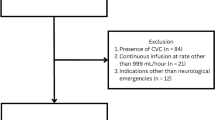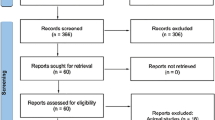Abstract
Background
Cerebrospinal fluid (CSF) leak following spinal surgery is a relatively common surgical complication. A disturbance in the underlying CSF dynamics could be the causative factor in a small group of patients with refractory CSF leaks that require multiple surgical repairs and prolonged hospital admission.
Methods
A retrospective case series of patients with persistent post spinal surgery CSF leak referred to the hydrocephalus service for continuous intracranial pressure (ICP) monitoring. Patients’ notes were reviewed for medical history, ICP data, radiological data, and subsequent management and outcome.
Results
Five patients (two males/three females, mean age, 35.4 years) were referred for ICP monitoring over a 12-month period. These patients had prolonged CSF leak despite multiple repair attempts 252 ± 454 days (mean ± SD). On ICP monitoring, all five patients had abnormal results, with the mean ICP 8.95 ± 4.41 mmHg. Four had abnormal pulse amplitudes, mean 6.15 mmHg ± 1.22 mmHg. All five patients underwent an intervention. Three patients underwent insertion of ventriculoperitoneal (VP) shunts. One patient had venous sinus stent insertion and one patient underwent medical management with acetazolamide. All five of the patients’ CSF leak resolved post intervention. The mean time to resolution of CSF leak post intervention was 10.8 ± 12.9 days.
Conclusions
Abnormal cerebrospinal fluid dynamics could be the underlying factor in patients with a persistent and treatment-refractory CSF leak post spinal surgery. Treatments aimed at lowering ICP may be beneficial in this group of patients. Whether abnormal pressure and dynamics represent a pre-existing abnormality or is induced by spinal surgery should be a subject of further study.


Similar content being viewed by others
References
Aaron G, Doyle J, Vaphiades MS, Riley KO, Woodworth BA (2014) Increased intracranial pressure in spontaneous CSF leak patients is not associated with papilledema. Otolaryngol Head Neck Surg 151(6):1061–1066
Albes G, Weng H, Horvath D, Musahl C, Bazner H, Henkes H (2012) Detection and treatment of spinal CSF leaks in idiopathic intracranial hypotension. Neuroradiology 54(12):1367–1373
Andresen M, Hadi A, Petersen LG, Juhler M (2015) Effect of postural changes on ICP in healthy and ill subjects. Acta Neurochir (Wien) 157(1):109–113
Bakshi R, Mechtler LL, Kamran S, Gosy E, Bates VE, Kinkel PR, Kinkel WR (1999) MRI findings in lumbar puncture headache syndrome: abnormal dural-meningeal and dural venous sinus enhancement. Clin Imaging 23(2):73–76
Balasubramaniam C, Rao SM, Subramaniam K (2014) Management of CSF leak following spinal surgery. Childs Nerv Syst 30(9):1543–1547
Brainard L, Chen DA, Aziz KM, Hillman TA (2012) Association of benign intracranial hypertension and spontaneous encephalocele with cerebrospinal fluid leak. Otol Neurotol 33(9):1621–1624
Bret P, Hor F, Huppert J, Lapras C, Fischer G (1985) Treatment of cerebrospinal fluid rhinorrhea by percutaneous lumboperitoneal shunting: review of 15 cases. Neurosurgery 16(1):44–47
Cammisa FP Jr, Girardi FP, Sangani PK, Parvataneni HK, Cadag S, Sandhu HS (2000) Incidental durotomy in spine surgery. Spine (Phila Pa 1976) 25(20):2663–2667
Chaaban MR, Illing E, Riley KO, Woodworth BA (2014) Spontaneous cerebrospinal fluid leak repair: a five-year prospective evaluation. Laryngoscope 124(1):70–75
Couture D, Branch CL Jr (2003) Spinal pseudomeningoceles and cerebrospinal fluid fistulas. Neurosurg Focus 15(6):E6
Dunn LT (2002) Raised intracranial pressure. J Neurol Neurosurg Psychiatry 73(Suppl 1):23–27
Galgano MA, Hazama A, Deshaies EM (2016) Refractory thoracolumbar cerebrospinal fluid leak after multiple spinal ependymoma resections treated with external ventricular drainage. Global Spine J 6(1):11–14
Hawk MW, Kim KD (2000) Review of spinal pseudomeningoceles and cerebrospinal fluid fistulas. Neurosurg Focus 9(1):E5
Higgins N, Trivedi R, Greenwood R, Pickard J (2015) Brain slump caused by jugular venous stenoses treated by stenting: a hypothesis to link spontaneous intracranial hypotension with idiopathic intracranial hypertension. J Neurol Surg Rep 76(1):188–193
Horev A, Hallevy H, Plakht Y, Shorer Z, Wirguin I, Shelef I (2013) Changes in cerebral venous sinuses diameter after lumbar puncture in idiopathic intracranial hypertension: a prospective MRI study. J Neuroimaging 23(3):375–378
Khazim R, Dannawi Z, Spacey K, Khazim M, Lennon S, Reda A, Zaidan A (2015) Incidence and treatment of delayed symptoms of CSF leak following lumbar spinal surgery. Eur Spine J 24(9):2069–2076
Koul R, Chacko A, Javed H, Jain R, Ganesh A, Srinivasan S (2002) Syndrome of cerebrospinal fluid hypovolemia following lumbar puncture cerebrospinal fluid leak in a patient with idiopathic intracranial hypertension. J Child Neurol 17(1):77–79
Linsler S, Schmidtke M, Steudel WI, Kiefer M, Oertel J (2013) Automated intracranial pressure-controlled cerebrospinal fluid external drainage with LiquoGuard. Acta Neurochir (Wien) 155(8):1589–1594
Matloob SA, Toma AK, Thorne L, Watkins LD (2015) Surgically managed idiopathic intracranial hypertension in adults: a single centre experience. Acta Neurochir (Wien) 157(12):2099–2103
Miglis MG, Levine DN (2010) Intracranial venous thrombosis after placement of a lumbar drain. Neurocrit Care 12(1):83–87
Misra SN, Morgan HW, Sedler R (2003) Lumbar myofascial flap for pseudomeningocele repair. Neurosurg Focus 15(3):E13
Mokri B (2002) Intracranial hypertension after treatment of spontaneous cerebrospinal fluid leaks. Mayo Clin Proc 77(11):1241–1246
Mokri B (2013) Spontaneous low pressure, low CSF volume headaches: spontaneous CSF leaks. Headache 53(7):1034–1053
Perez MA, Bialer OY, Bruce BB, Newman NJ, Biousse V (2013) Primary spontaneous cerebrospinal fluid leaks and idiopathic intracranial hypertension. J Neuroophthalmol 33(4):330–337
Pickard JD, Czosnyka Z, Czosnyka M, Owler B, Higgins JN (2008) Coupling of sagittal sinus pressure and cerebrospinal fluid pressure in idiopathic intracranial hypertension—a preliminary report. Acta Neurochir Suppl 102:283–285
Pouskoulas CD, Taub E, Ruppen W (2013) Successful treatment of post-dural-puncture headache with surgical dura repair two years after spinal anesthesia. Cephalalgia 33(15):1269–1271
Rosenfeld E, Dotan G, Kimchi TJ, Kesler A (2013) Spontaneous cerebrospinal fluid otorrhea and rhinorrhea in idiopathic intracranial hypertension patients. J Neuroophthalmol 33(2):113–116
Schlosser RJ, Wilensky EM, Grady MS, Palmer JN, Kennedy DW, Bolger WE (2004) Cerebrospinal fluid pressure monitoring after repair of cerebrospinal fluid leaks. Otolaryngol Head Neck Surg 130(4):443–448
Settipani N, Piccoli T, La Bella V, Piccoli F (2004) Cerebral venous sinus expansion in post-lumbar puncture headache. Funct Neurol 19(1):51–52
Sussman WI, Shaw E (2014) Intracranial hypertension after spinal cord injury and suboptimal cervical fusion. PM R 6(2):199–202
Vivas EX, Mccall A, Raz Y, Fernandez-Miranda JC, Gardner P, Hirsch BE (2014) ICP, BMI, surgical repair, and CSF diversion in patients presenting with spontaneous CSF otorrhea. Otol Neurotol 35(2):344–347
Weng YJ, Cheng CC, Li YY, Huang TJ, Hsu RW (2010) Management of giant pseudomeningoceles after spinal surgery. BMC Musculoskelet Disord 11:53
Wolff S, Kheirredine W, Riouallon G (2012) Surgical dural tears: prevalence and updated management protocol based on 1359 lumbar vertebra interventions. Orthop Traumatol Surg Res 98(8):879–886
Author information
Authors and Affiliations
Corresponding author
Ethics declarations
Funding
No funding was received for this research.
Conflict of interest
All authors certify that they have no affiliations with or involvement in any organization or entity with any financial interest (such as honoraria; educational grants; participation in speakers’ bureaus; membership, employment, consultancies, stock ownership, or other equity interest; and expert testimony or patent-licensing arrangements), or non-financial interest (such as personal or professional relationships, affiliations, knowledge or beliefs) in the subject matter or materials discussed in this manuscript.
Ethical approval
All procedures performed in studies involving human participants were in accordance with the ethical standards of the institutional and/or national research committee and with the 1964 Helsinki Declaration and its later amendments or comparable ethical standards.
Informed consent
For this type of study formal consent is not required.
Rights and permissions
About this article
Cite this article
Craven, C., Toma, A.K., Khan, A.A. et al. The role of ICP monitoring in patients with persistent cerebrospinal fluid leak following spinal surgery: a case series. Acta Neurochir 158, 1813–1819 (2016). https://doi.org/10.1007/s00701-016-2882-5
Received:
Accepted:
Published:
Issue Date:
DOI: https://doi.org/10.1007/s00701-016-2882-5




